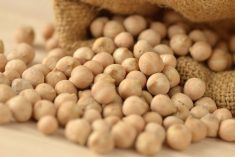Glacier FarmMedia—The heat wave that hit much of the Prairies earlier this month proved that there can be too much of a good thing, according to the Saskatchewan government’s provincial pulse specialist.
After heavy rainfall earlier this summer caused flooding in low-lying areas and washed out some pulse acres, Dale Risula said growers couldn’t wait for the heat to help crops develop. Now, the warmer and drier conditions are doing more harm than good.
“Initially, it was good because we had a cool start to the summer. You need to have some heat units for plants to start growing. Consequently, the heat finally hit and I think the plants started growing very rapidly,” he said. “Too much heat can be a negative thing. I don’t think that’s hit yet. But if this heat wave persists for an extended amount of time, I’d start looking for stuff to happen.”
Read Also

U.S. grains: Chicago grains firm as traders gauge China purchases
Chicago | Reuters – Chicago soybean futures ticked up on Wednesday as traders eyed Chinese purchases of U.S. beans under…
Risula warned that the heat can cause crops to be more susceptible to disease. He doesn’t think the heat wave has lasted long enough to lead to reduced yields, but more precipitation will be welcome from now until harvest.
“Once the pods start developing, then they’re going to start needing moisture in that point of time,” he said. “I think right now there is a great deal of evapo-transpiration taking place out there, in both the soil and the plants. A lot of moisture is being lost due to the heat.”
Agriculture and Agri-Food Canada (AAFC) released its monthly estimates on July 22 and raised many of them for pulses compared to those from June.
The seeded area for dry peas in 2024-25 was pegged at 1.3 million hectares, 36,000 more than the June estimate and 67,000 more than the 2023-24 total. Production was estimated to be 3.3 million tonnes, compared to three million from the previous month and the 2023-24 total of 2.609 million. Ending stocks were set to be 440,000 tonnes, 200,000 more than the June estimate and 215,000 more than in 2023-24.
For lentils, AAFC estimated 1.704 million hectares of seeded area, compared to 1.55 million from June and 1.485 million in 2023-24. Production was slated at 2.5 million tonnes, 370,000 more than the June estimate and 819,000 more than the 2023-24 total. Ending stocks were projected at 450,000 tonnes compared to 190,000 from the June report and 50,000 from 2023-24.
Dry beans were sown in 150,000 hectares, according to AAFC’s July estimate, up 5,000 from June and up 21,000 from 2023-24. Production was guessed at 375,000 tonnes, up 20,000 from the June estimate and up 36,000 from 2023-24. Ending stocks were unchanged at 40,000 tonnes, double the amount from 2023-24.
Chickpea area was reported at 184,000 hectares, 22,000 more than the June estimate and 56,000 more than the total from 2023-24. A crop of 305,000 tonnes was estimated for 2024-25, compared to 225,000 in last month’s report and 142,000 from 2023-24. Ending stocks were raised 40,000 tonnes from June at 85,000, compared to only 1,000 tonnes in 2023-24.















